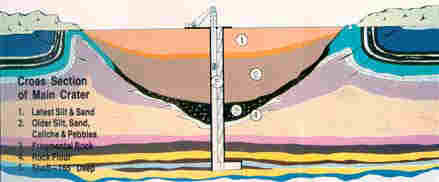

|
The Odessa Crater, and four smaller craters, were formed in prehistoric time when a great shower of nickel-iron meteorites collided with the earth. It is estimated the event occurred some 62,000 years ago. The shower was composed of many thousands of individual meteorites of various sizes which fell over an area of about 2 square miles. The smaller meteorites, which were by far the most numerous, either came to rest on the earth's surface or at the bottom of shallow impact pits within the soil. There were several very large meteoric masses in the shower, however, and these struck the earth with such enormous energy that they penetrated deeply into bedrock producing craters in the earth at the places of impact. When freshly formed, the craters were funnel-shaped depressions, the largest about 550 feet in diameter and 100 feet in depth. More than 100,000 cubic yards of crashed rock as ejected from this crater by the energy released from the impacting meteoric mass. Smaller craters in the vicinity of the main crater range form 15 feet to 70 feet in diameter and from 7 feet to 18 feet in depth. In the ages following their formation the craters gradually accumulated sediments deposited by wind and water. The main crater was eventually filled to within 6 feet of the level of the surrounding plain. It now appears a shallow, nearly circular depression surrounded by a rock-buttressed rim. The several smaller associated craters were so completely buried that their existence was not suspected until they were exposed in excavations made by the University of Texas, in the early 1940's. Meteor craters are among the rarest and most interesting of land features. Astrophysicists have observed the source of meteoritic bodies which strike our earth originate within our Solar System, probably from the asteroidal belt located between the planets Mars and Jupiter.
|
 |
|
A 165 foot shaft was sunk in the center of the main crater primarily to locate the main mass of the meteorite, which was believed still buried. However, the shaft revealed that there was no huge mass buried. It is now known that the mass, of an estimated 70 tons, which formed the main crater, was traveling at such a high rate of speed that it exploded and vaporized upon contact with the earth. Therefore, the main crater is a "explosion crater". The four smaller craters were formed by smaller masses of meteoric material. These were slowed down by te earth's atmosphere to below explosion velocity. The craters were formed by the impact of the meteorite, and much of the meteoric material was buried at the bottom of the small craters. These smaller craters are, therefore, "impact craters". The smaller craters had been completely covered by wind blown dirt and were located by metal detection equipment. In addition to the meteoric material recovered form the smaller craters, many tons of meteorite fragments were scattered over the surrounding plain. The fragments, upon impact, buried themselves at depths from a few inches to a few feet, depending on their size. The largest piece of the Odessa Meteorite ever found weighs approximately 300 pounds. The Odessa Meteorite is an iron or metallic meteorite. Only about 10% of all the meteorites striking the earth are metallic. The remaining 90% are classified as stoney meteorites and resemble rocks found on earth. Because they so closely resemble rocks, stoney meteorites are much harder to find and are more valuable than metallic meteorites. Originally the 165 foot shaft was completely walled up with heavy timbers and divided into 10 different floor levels, with ladders connecting each floor. However, in the early 1950's, someone set fire to the timbers in the shaft, completely destroying them. The shaft is now covered with concrete slabs. The Odessa crater is the second largest recognizeable crater recognized in the United States. The largest is the Arizona Crater. The Odessa Crater is approximately 500 feet across and was originally 100 feet deep. Wind and rain have filled it up over the centuries until it is now only about 15 feet deep. The Arizona Crater is 4,000 feet across and 500 feet deep. |
